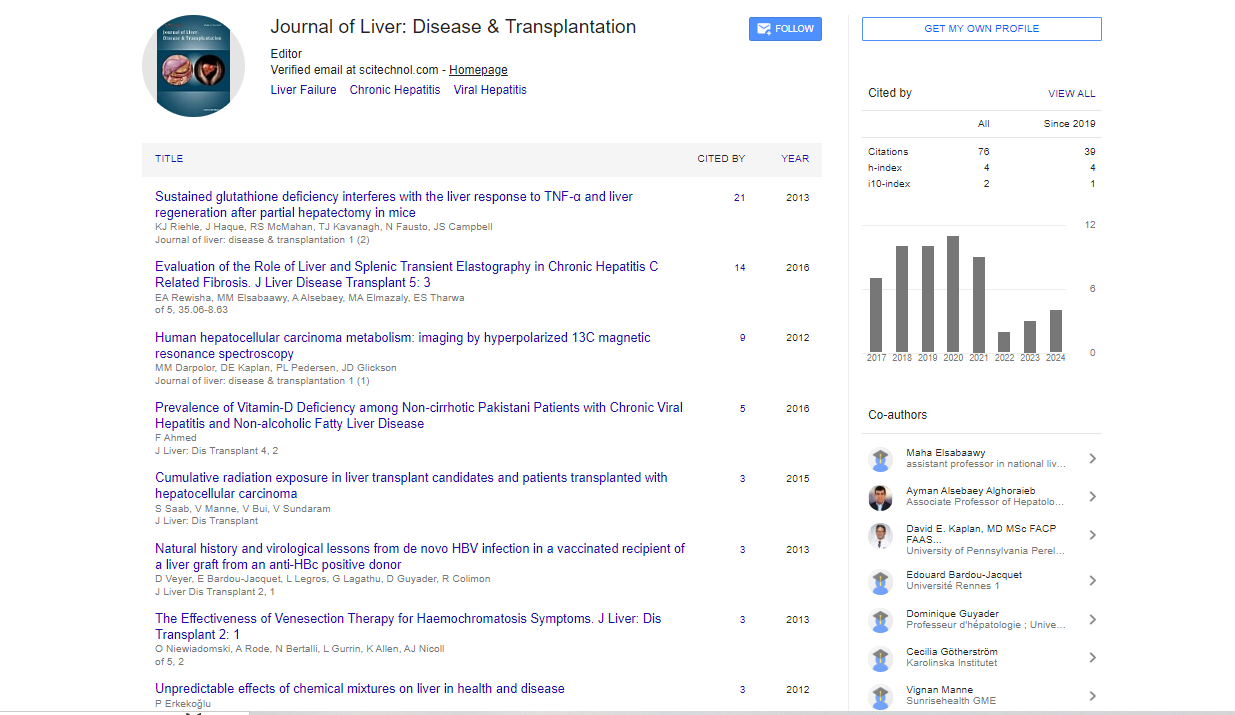Opinion Article, J Liver Disease Transplant Vol: 13 Issue: 4
Gut Microbiome and Its Role in the Progression of Liver Fibrosis
Olivia Anderson*
1Department of Hepatic Surgery, University Hospital Southampton, United Kingdom
*Corresponding Author: Olivia Anderson,
Department of Hepatic Surgery,
University Hospital Southampton, United Kingdom
E-mail: andeo@uhsuk.uk
Received date: 28 November, 2024 Manuscript No. JLDT-24-156891;
Editor assigned date: 02 December, 2024, PreQC No. JLDT-24-156891 (PQ);
Reviewed date: 16 December, 2024, QC No. JLDT-24-156891;
Revised date: 23 December, 2024, Manuscript No. JLDT-24-156891 (R);
Published date: 30 December, 2024, DOI: 10.4172/2325-9612.1000289.
Citation: Anderson O (2024) Gut Microbiome and Its Role in the Progression of Liver Fibrosis. J Liver Disease Transplant 13:4.
Description
The gut microbiome plays an important role in maintaining the balance of human health by influencing various physiological processes, including those related to the liver. The liver, a central metabolic organ, is closely linked to the gut through the gut-liver axis. This bidirectional relationship involves the exchange of microbial metabolites, toxins and inflammatory signals, which can have profound effects on liver health, particularly in the context of liver fibrosis. Liver fibrosis is a common pathological consequence of chronic liver diseases, including Non-Alcoholic Fatty Liver Disease (NAFLD), Alcoholic Liver Disease (ALD) and chronic hepatitis B or C. It is characterized by the excessive accumulation of extracellular matrix components in the liver, leading to increased tissue stiffness and the potential progression to cirrhosis. The gut microbiome has been implicated as a key player in the pathogenesis of liver fibrosis through multiple mechanisms.
One of the primary mechanisms linking the gut microbiome to liver fibrosis is the role of gut-derived metabolites and toxins. The gut microbiota produces a range of metabolites, including Short-Chain Fatty Acids (SCFAs), bile acids and Lipopolysaccharides (LPS). Disruption of the gut microbiome can lead to an imbalance in these metabolites. For instance, an increased production of LPS, a component of the outer membrane of Gram-negative bacteria, can contribute to systemic inflammation by activating Toll-Like Receptor 4 (TLR4) pathways. Elevated levels of LPS have been associated with chronic liver diseases and the progression of fibrosis. LPS stimulates Hepatic Stellate Cells (HSCs), the primary fibrogenic cells in the liver, leading to the release of pro-inflammatory and fibrogenic cytokines, thereby accelerating fibrosis progression.
In addition to LPS, bile acids plays an important role in the gutliver axis. Bile acids are synthesized in the liver and released into the gut, where they facilitate the absorption of lipids and fat-soluble vitamins. The gut microbiome modulates the pool of bile acids through deconjugation and transformation, influencing their composition and function. An altered bile acid profile, often observed in liver fibrosis, can exacerbate liver injury. For example, secondary bile acids produced by dysregulated microbiota can activate the Farnesoid X Receptor (FXR), a nuclear receptor that regulates bile acid homeostasis. FXR activation has been shown to promote HSC activation and collagen deposition, contributing to fibrogenesis.
Another significant way the gut microbiome impacts liver fibrosis is through the production of SCFAs. SCFAs, primarily acetate, propionate and butyrate, are metabolic byproducts of fermentation of dietary fibers by gut microbiota. These SCFAs have anti-inflammatory and regulatory roles in the gut-liver axis. However, in the context of liver fibrosis, the balance of SCFAs is disrupted. A reduction in butyrate, in particular, has been linked to the activation of HSCs and the release of pro-fibrotic mediators, accelerating fibrogenesis. Moreover, SCFAs have been shown to modulate the production of gutderived hormones such as Glucagon-Like Peptide-1 (GLP-1) and bile acid synthesis, further influencing liver function and fibrosis progression.
The gut microbiome also affects the immune response, particularly the intestinal barrier integrity. A compromised gut barrier, resulting from microbial dysbiosis, allows for the translocation of endotoxins and pathogens into systemic circulation. This condition, known as intestinal permeability or "leaky gut," promotes chronic low-grade inflammation, contributing to the progression of liver fibrosis. Elevated systemic inflammatory markers, such as Tumor Necrosis Factor-Alpha (TNF-α) and Interleukin-6 (IL-6), have been linked to microbial dysbiosis and are known drivers of HSC activation and collagen deposition in the liver.
Furthermore, the gut microbiome influences the production of antimicrobial peptides, which play a role in maintaining gut homeostasis. A reduced abundance of protective microbial species, such as Akkermansia muciniphila and an overgrowth of pathogenic bacteria can lead to decreased production of these peptides, further compromising the gut-liver axis. The loss of protective microbial species and the expansion of harmful ones have been associated with increased intestinal permeability, systemic inflammation and the progression of liver fibrosis.
Conclusion
Overall, the gut microbiome contributes to liver fibrosis through multiple interconnected mechanisms, including the production of harmful metabolites like LPS and bile acids, disruption of SCFA production, compromised gut barrier integrity and altered immune responses. Understanding the relationship between the gut microbiome and liver fibrosis could provide new awareness into therapeutic strategie s aimed at modulating gut microbiota to prevent or reduce liver fibrosis progression. Interventions such as probiotics, prebiotics and Fecal Microbiota Transplants (FMT) hold assurance as potential therapeutic approaches to restore gut microbiome balance, enhance liver health and reduce the burden of liver fibrosis.
 Spanish
Spanish  Chinese
Chinese  Russian
Russian  German
German  French
French  Japanese
Japanese  Portuguese
Portuguese  Hindi
Hindi 